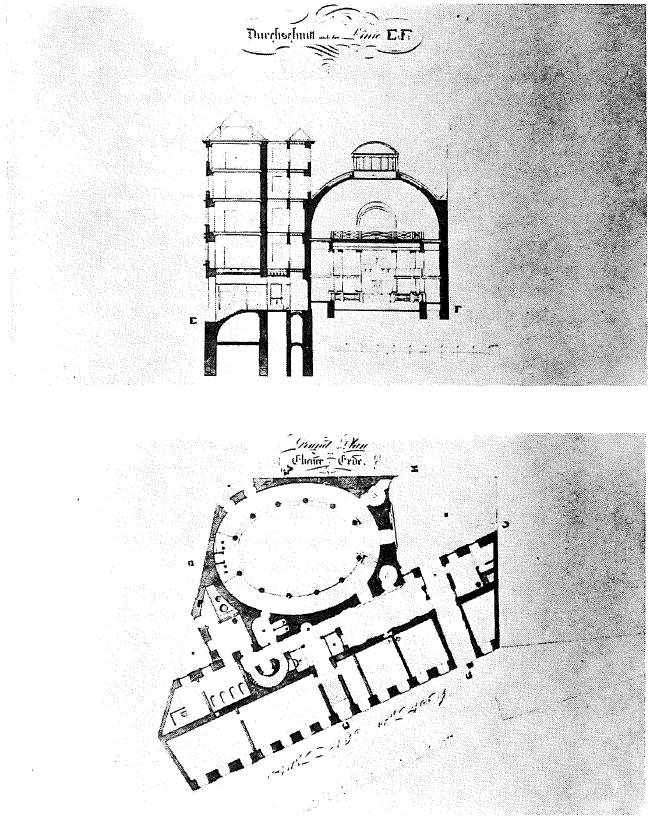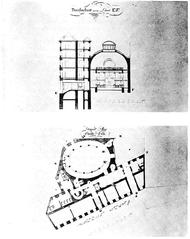
Stadttempel Vienna: Comprehensive Visiting Guide, Tickets, and Historical Insights
Date: 14/06/2025
Introduction
The Stadttempel stands as Vienna’s principal synagogue, a living testament to the city’s rich Jewish heritage, architectural ingenuity, and cultural resilience. Built discreetly within the Innere Stadt between 1824 and 1826 by architect Joseph Kornhäusel, it was designed without a street-facing façade, both to comply with Habsburg regulations and, unintentionally, to safeguard it from destruction during the Kristallnacht pogrom. Today, the Stadttempel remains the only surviving synagogue among Vienna’s original 94, serving as a vibrant center of Ashkenazi Orthodox religious life and a symbol of Jewish endurance (Jewish Museum Vienna, Vienna Info, World Jewish Travel).
This guide provides all essential information for visitors—from historical context and architectural highlights to visiting hours, ticketing, accessibility, and travel tips—ensuring a meaningful and respectful experience for all.
Table of Contents
- Introduction
- Historical Background and Early History
- Architectural Features and Innovations
- Stadttempel During the Holocaust
- Memorial and Contemporary Role
- Visiting Stadttempel: Hours, Tickets, Accessibility
- Guided Tours: Structure and Experience
- Nearby Attractions and Travel Tips
- Visitor FAQs
- Visuals and Media
- Conclusion and Call to Action
- Sources
Historical Background and Early History
Following Emperor Joseph II’s Edict of Tolerance in 1782, Vienna’s Jewish community gained limited rights, including the ability to worship more openly. However, synagogue construction faced strict regulations. In 1824, permission was granted for a synagogue within the city walls, marking a milestone in Jewish integration. Designed by Joseph Kornhäusel, the Stadttempel was completed in 1826 and deliberately built within a block of residential buildings at Seitenstettengasse 4, remaining hidden from the street (Jewish Museum Vienna). This concealment was both a legal requirement and, later, a key factor in its survival during the Holocaust.
Architectural Features and Innovations
Stylistic Context and Architect
Joseph Kornhäusel, a renowned Biedermeier and Neoclassical architect, infused the Stadttempel with elements of both restraint and elegance (Life of the Synagogue). The synagogue’s design reflects the social realities of the time, as only Catholic churches could have street-facing facades (World Jewish Travel; Vienna Info).
Interior Innovation
The main sanctuary is oval, encircled by twelve Ionic columns symbolizing the Twelve Tribes of Israel. These columns support two women’s galleries, reminiscent of the arrangement in contemporary theaters—a nod to Kornhäusel’s experience in theater architecture. The interior features a domed ceiling with a skylight, parquet flooring, ornate chandeliers, and gold motifs, creating a serene and uplifting space for worship (Vienna Itineraries).
The bimah (pulpit) and ark are uniquely combined and placed against the eastern wall, departing from the traditional centrally placed bimah. This arrangement, influenced by reforms of the era, enhances visibility and acoustics (IKG Vienna).
Influence and Legacy
The Stadttempel’s architectural solutions—its concealed exterior, oval sanctuary, and integrated galleries—were innovative for their time and served as models for later synagogues throughout Europe (Spotlight Anu Museum).
Stadttempel During the Holocaust
On Kristallnacht (November 1938), nearly all of Vienna’s synagogues and prayer houses were destroyed. The Stadttempel survived because its location within a residential block made destruction too risky for surrounding buildings (USHMM). While the building endured, Vienna’s Jewish community suffered irreparable losses. Today, the Stadttempel stands as the sole surviving architectural witness to the city’s once-flourishing Jewish life.
Memorial and Contemporary Role
Shoah Memorial
A poignant memorial in the synagogue’s foyer lists the names of 65,000 murdered Austrian Jews on rotating slate tablets. A broken granite column at the center symbolizes the devastation of Vienna’s Jewish community during the Shoah (Vienna Info). This space, designed by Thomas Feiger, integrates remembrance into the synagogue’s daily life.
Security and Accessibility
Due to its active role and historical significance, the Stadttempel has modern security measures. All visitors must present photo ID and pass a security screening (Jewish Vienna). The main sanctuary is wheelchair accessible, though some exhibition rooms may have steps; assistance is available upon request.
Ongoing Community Life
The synagogue continues to serve Vienna’s Jewish community, hosting regular Ashkenazi Orthodox services, life-cycle events, and cantorial music traditions (JGuide Europe). It also collaborates with the Jewish Museum Vienna to provide educational programs and guided tours.
Visiting Stadttempel: Hours, Tickets, and Accessibility
Visiting Hours
- Guided Tours: Generally available on weekdays (Monday to Friday), typically at 10:00 AM. Check the Jewish Museum Vienna’s official website for the current schedule.
- Closed: Saturdays, Jewish holidays, and some Sundays.
Tickets and Booking
- Tickets: Guided tour admission is approximately €12 per person, with discounts for students and seniors. Children under 12 are often free (Travelers Universe).
- Booking: Advance booking via the Jewish Museum Vienna is required due to limited capacity and security regulations.
- Admission to Prayer Services: Free, but non-members must register at least three days in advance by providing passport details (IKG Wien).
Accessibility
- Wheelchair Access: The main sanctuary is accessible; some exhibition areas may not be. Notify in advance for assistance.
- Dress Code: Modest attire required (shoulders and knees covered; head coverings for men are available on-site).
Guided Tours: Structure and Experience
Guided tours, lasting about one hour, are led by knowledgeable guides—often members of Vienna’s Jewish community—who provide both architectural and historical insights (Travelers Universe). Tours include:
- Architectural highlights: Sanctuary, galleries, ark, and Shoah memorial.
- Historical storytelling: The evolving role of the synagogue, survival during the Holocaust, and the rebuilding of the community.
- Visitor engagement: Q&A sessions, opportunities for reflection, and respectful dialogue.
Tours are available in English, German, and occasionally other languages upon request.
Nearby Attractions and Travel Tips
Location
- Address: Seitenstettengasse 4, 1010 Vienna (Innere Stadt)
- Public Transport: U-Bahn U3 (Stephansplatz), tram lines 1, 2, D. Use public transport as parking is limited.
Nearby Sites
- Jewish Museum Vienna
- St. Stephen’s Cathedral (Stephansdom)
- Vienna State Opera
- Historic city squares, cafés, and the vibrant Jewish quarter
Travel Tips
- Arrive early for security screening.
- Photography is restricted during services—check with your guide.
- Dress modestly and behave respectfully as this is an active place of worship.
Visitor FAQs
Q: What are the Stadttempel’s visiting hours?
A: Guided tours are generally Monday to Friday at 10:00 AM; check the latest schedule online.
Q: How do I buy tickets?
A: Tickets must be booked in advance through the Jewish Museum Vienna.
Q: Is the synagogue wheelchair accessible?
A: The main sanctuary is, but some exhibition areas may not be. Contact staff for specific needs.
Q: Can non-members attend prayer?
A: Yes, but registration with passport details is required at least three days in advance.
Q: Are guided tours available in English?
A: Yes, tours are offered in English and German; other languages may be available on request.
Q: Is photography allowed?
A: Photography is restricted; always ask your guide before taking pictures.
Visuals and Media
Enhance your experience with virtual tours and photo galleries available on the Jewish Museum Vienna’s website. Suggested image descriptions include:
- “Stadttempel Vienna synagogue exterior with discreet facade”
- “Interior view of Stadttempel sanctuary with chandeliers and vaulted ceilings”
- “Shoah memorial with engraved names in the Stadttempel foyer”
Conclusion and Call to Action
The Stadttempel is not just an architectural masterpiece but a profound symbol of Vienna’s Jewish history, resilience, and cultural richness. Its discreet exterior belies a sanctuary filled with beauty, memory, and living tradition. A visit here offers deep insight into not only the Jewish experience in Vienna but also the broader narrative of European history.
Plan your visit by booking a guided tour through the Jewish Museum Vienna. Enhance your journey with the Audiala app, offering up-to-date information, exclusive audio guides, and curated content on Vienna’s historical sites. Follow us on social media for new articles, events, and travel inspiration.
Related Articles
Sources
- Jewish Museum Vienna
- Vienna Info
- World Jewish Travel
- Travelers Universe
- JGuide Europe
- Jewish Vienna
- Spotlight Anu Museum
- IKG Vienna
- Life of the Synagogue
- Vienna Itineraries
- USHMM






















































































































































